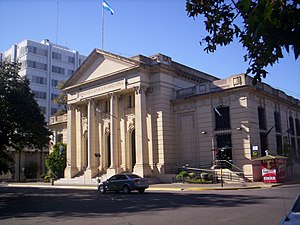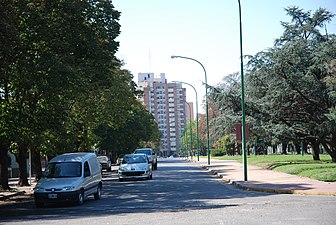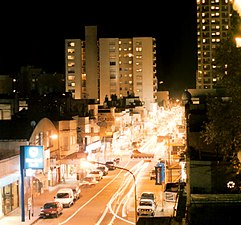Junín, Buenos Aires
This article needs additional citations for verification. (March 2012) |
Junín | |
|---|---|
City | |
 Downtown Junín | |
|
Coat of arms of Junín Coat of arms | |
| Coordinates: 34°35′S 60°57′W / 34.583°S 60.950°W | |
| Country | |
| Province | |
| Partido | Junín |
| Founded | December 27, 1827 |
| Elevation | 81 m (266 ft) |
| Population | |
• Total | 85,420 |
| • Density | 3,434/km2 (8,890/sq mi) |
| CPA Base | B 6000 |
| Area code | +54 236 |
| Website | Official website |
Junín (IPA: [xuˈnin]) is a city in the province of Buenos Aires, Argentina, and administrative seat of the county (partido) of Junín. It has a population of 85,420 (2010 census [INDEC]) and is located 260 km (162 mi) west of the city of Buenos Aires. It is most famous as the hometown of former first lady of Argentina, Eva Peron.
History
Inhabited by the native Charrúa people, the site's strategic location on the Salado River made it of interest to Spanish Viceroy Juan José de Vértiz y Salcedo, who established an outpost there in the 1790s as part of a line of defense against raids by displaced natives. The location became known as El Potroso.
El Potroso was reinforced by a fort by way of an 1826 decree by President Bernardino Rivadavia, and on December 27, 1827, the citadel was established under the command of a veteran of the Argentine War of Independence, Bernardino Escribano, as Fuerte de la Federación. The advent of Buenos Aires Province Governor Juan Manuel de Rosas led to Escribano's 1829 destitution as commander; though the intervention of an officer, Isidoro Suárez, averted a bloodbath. Suárez, a veteran of one of the last battles of the War for Independence (the Battle of Junín, in Perú), inadvertently gave the failing settlement its new name by his actions: "Junín."
Political conflict and ongoing Indian raids had all but destroyed Junín by the 1830s, however, and this prompted Governor Rosas to send the remaining settlers provisions and to subsidize crop farming in the surrounding, fertile pampas fields. This was followed by a pact with Ranquel Chief Santiago Yanquelén, whereby his people would defend Junín against raids by other tribes. Towards the end of his rule, Rosas appointed José Seguí, among the few Afro Argentines to achieve a commissioned officer's rank, to administer Junín, in 1851. Seguí was an efficient, though repressive commander, and in 1863, he was assassinated at his nearby ranch.
Rosas' 1852 overthrow resulted in the appointment of a justice of the peace, who initially shared governing duties with the military commander. Junín's first general store (Basterreix) opened in 1860, and in 1861, Junín elected its first city council (despite being officially only a fort). The province designated the area as a county in 1864, and with nearly 2,000 inhabitants, Junín ceases to be categorized as a "fort," and its first municipal master plan was laid out in 1865.

The 1880 arrival of the Central Argentine Railway and that of the Buenos Aires and Pacific Railway (B.A.& P.) in 1884 led to the town's rapid growth. The National Bank of Argentina had opened a branch there in 1892 and by the 1895 census, Junín was home to over 12,000. The town largest employer by then was the B.A.& P.'s rail equipment factory, which employed over 1,600. The City Hall was completed in 1904 and Junín was declared a "city," in 1906.
Junín's steady development over the subsequent decades and setting amid lakes made it a well-known regional tourist destination. A hunting club was established in 1938, and a fishermen's pier and club on Lake El Carpicho, in 1942. The Aero Club Junín (1940) became well-known following the IX International Gliding Competition, in 1963, and the nearby Borchex Municipal Park and Lake Gómez both have become popular weekend destinations since the 1960s; Lake Gómez attracted around 350,000 visitors during the 2006-07 summer season. Nearby Estancia La Oriental has attracted growing rural tourism to the area, as well.
The city is home to an important Municipal Historical Museum, probably best known for its paleontology hall and its wooly mammoth fossils, and the Ángel María de Rosa Municipal Museum of Art (1944). In a bid to further diversify the city's economy, an industrial park was authorized north of the city in 1995, and a racetrack, the Autódromo Eusebio Marcilla, was opened in 2003. The closure of much of Argentina's passenger rail service during the 1990s was partly offset in Junín in part by the purchase of local rail facilities by América Latina Logística, a São Paulo-based rail transport provider operating largely in Argentina, as well as by establishment of the Junín Railworks Cooperative.
The city features numerous cinemas, as well as prominent stage theatres such as the Teatro de la Ranchería (1971). The city's first institution of higher learning, the Junín Regional University (CURJ), was established in 1990; fused with its nearby, Pergamino counterpart, it became the National University of Northwestern Buenos Aires (UNNOBA), in 2002. The public Dr. Abraham Piñeyro Emergency Hospital, opened in 1930, serves as the city's principal health care establishment; a new wing was added to the facility in 1997.
Famous people from Junín include Argentine supermodel Yesica Toscanini, Tour de France cyclist Juan Antonio Flecha, football greats such as coach Osvaldo Zubeldía, forward Atilio García and goalie Federico Vilar, the "wild bull of the pampas," boxer Luis Ángel Firpo and Elvira Rawson de Dellepiane, a militant suffragist and the second woman to receive a medical degree in Argentina; Junín was also where Eva Duarte was raised until an opportunity in radio took her to Buenos Aires, in 1935. A decade later, she became the influential Eva Perón (Evita).
A fellow UCR figure, Moisés Lebensohn, founded the city's leading newsdaily, Democracia, in 1931.
The city's mayor, elected in 2015, is Pablo Petrecca of Cambienos-PRO.
Gallery
-
View of Junín and the Río Salado
-
Local branch of the National Bank of Argentina
-
25 May Square
-
Estancia La Oriental
-
Church of St. Ignatius of Loyola
-
Church of the Sacred Heart
-
San Martín Avenue
-
The Ángel María de Rosa Museum of Art
-
Gyula Kosice's Millenium Fountain
-
Sáenz Peña Avenue
-
Abraham Piñeyro Hospital
-
Junín Railway Station
-
Fishermen's Pier on Lake El Carpincho
-
Mayor Borchex Municipal Park
-
Pier on Lake Gómez
Climate
Junín has a humid subtropical climate (Köppen climate classification Cfa).[1] Winters are characterized with moderate temperatures during the day and cold nights.[2] In the coldest month, July, the average high is 15.1 °C (59.2 °F) while the average low is 4.2 °C (39.6 °F).[3] Temperatures can occasionally fall below freezing during cold waves although during heat waves such as the 2009 heat wave, temperatures can reach up to 35 °C (95.0 °F) when a record high of 35.3 °C (95.5 °F) was recorded on August 29, 2009.[4] During this time of the year, overcast days are more common, averaging 9–11 days per month although sunny days are common as well with 7-11 clear days per month from June to September.[2] Spring and fall are transition seasons featuring warm daytime temperatures and cool nighttime temperatures and are highly variable with some days reaching 37.6 °C (99.7 °F) and below −9.2 °C (15.4 °F).[2] Summers are hot during the day while nights are mild.[2] They tend to be sunnier than the other seasons, averaging 8–11 clear days with less overcast days (only 6 per month).[2] In the hottest month, January, the average high is 30.2 °C (86.4 °F) while the average low is 16.2 °C (61.2 °F).[3] The average relative humidity is 75%, with the summer months being drier than the winter months.[3] The average first date of frost is on May 20 while the last date of frost is on September 11.[4] This can vary from year to year with frosts that can extend into November or occur as early as April.[4] Junín is moderately windy throughout the entire year with wind speeds ranging from a low of 8.6 kilometres per hour (5.3 mph) in April to 14.4 kilometres per hour (8.9 mph) in September.[2] On average, Junín receives 993.4 millimetres (39 in) of precipitation per year with 85 days with measureable precipitation with summer months being more wetter than the winter months, where most of the precipitation falls in the form of thunderstorms.[3][5] Junín receives approximately 2,569.3 hours of bright sunshine per year or 57% of possible sunshine per year, ranging from a low of 46% in June (only 138.0 hours of sunshine per month) to a high of 66% in both January and February.[3] The highest recorded temperature was 41.8 °C (107.2 °F) on December 29, 1971 while the lowest recorded temperature was −9.2 °C (15.4 °F) on June 14, 1967.[6]
| Climate data for Junín (1981–2010, extremes 1961–present) | |||||||||||||
|---|---|---|---|---|---|---|---|---|---|---|---|---|---|
| Month | Jan | Feb | Mar | Apr | May | Jun | Jul | Aug | Sep | Oct | Nov | Dec | Year |
| Record high °C (°F) | 40.6 (105.1) |
39.7 (103.5) |
37.6 (99.7) |
34.5 (94.1) |
31.8 (89.2) |
27.3 (81.1) |
30.8 (87.4) |
35.3 (95.5) |
37.0 (98.6) |
37.3 (99.1) |
38.5 (101.3) |
41.8 (107.2) |
41.8 (107.2) |
| Mean daily maximum °C (°F) | 29.8 (85.6) |
28.4 (83.1) |
26.6 (79.9) |
22.6 (72.7) |
19.0 (66.2) |
15.5 (59.9) |
15.0 (59.0) |
17.7 (63.9) |
19.7 (67.5) |
22.7 (72.9) |
26.0 (78.8) |
28.8 (83.8) |
22.7 (72.9) |
| Daily mean °C (°F) | 23.0 (73.4) |
21.7 (71.1) |
19.7 (67.5) |
15.8 (60.4) |
12.4 (54.3) |
9.3 (48.7) |
8.6 (47.5) |
10.7 (51.3) |
12.9 (55.2) |
16.3 (61.3) |
19.4 (66.9) |
22.0 (71.6) |
16.0 (60.8) |
| Mean daily minimum °C (°F) | 16.6 (61.9) |
15.8 (60.4) |
14.2 (57.6) |
10.4 (50.7) |
7.2 (45.0) |
4.5 (40.1) |
3.6 (38.5) |
4.8 (40.6) |
6.7 (44.1) |
10.1 (50.2) |
12.8 (55.0) |
15.2 (59.4) |
10.2 (50.4) |
| Record low °C (°F) | 6.0 (42.8) |
5.0 (41.0) |
1.0 (33.8) |
−3.4 (25.9) |
−7.5 (18.5) |
−9.2 (15.4) |
−8.0 (17.6) |
−7.0 (19.4) |
−4.5 (23.9) |
−3.4 (25.9) |
1.2 (34.2) |
2.2 (36.0) |
−9.2 (15.4) |
| Average precipitation mm (inches) | 132.3 (5.21) |
118.8 (4.68) |
133.2 (5.24) |
109.1 (4.30) |
61.2 (2.41) |
26.8 (1.06) |
31.5 (1.24) |
32.4 (1.28) |
53.3 (2.10) |
122.8 (4.83) |
110.7 (4.36) |
110.0 (4.33) |
1,042.1 (41.03) |
| Average precipitation days (≥ 0.1 mm) | 8.2 | 7.8 | 9.0 | 7.6 | 5.3 | 4.4 | 4.8 | 4.5 | 5.9 | 9.9 | 9.2 | 8.6 | 85.2 |
| Average relative humidity (%) | 69.6 | 74.4 | 77.2 | 77.8 | 78.5 | 79.3 | 77.1 | 72.3 | 70.1 | 71.1 | 67.8 | 65.9 | 73.4 |
| Mean monthly sunshine hours | 291.4 | 249.2 | 229.4 | 198.0 | 167.4 | 138.0 | 148.8 | 186.0 | 201.0 | 223.2 | 261.0 | 275.9 | 2,569.3 |
| Percent possible sunshine | 66 | 66 | 60 | 59 | 53 | 46 | 48 | 55 | 57 | 56 | 62 | 61 | 57 |
| Source 1: Servicio Meteorológico Nacional[7][6] | |||||||||||||
| Source 2: NOAA (sun 1961–1990)[3] | |||||||||||||
Transportation
The city is served by Junín Airport, which has no commercial air service but has had so in the past.
Notable people
- Juan Antonio Flecha, cyclist
- Luis Angel Firpo, boxer
- Eva Perón, Argentine First Lady
References
- ^ Peel, M. C. and Finlayson, B. L. and McMahon, T. A. (2007). "Updated world map of the Köppen–Geiger climate classification" (PDF). Hydrol. Earth Syst. Sci. 11: 1633–1644. doi:10.5194/hess-11-1633-2007. ISSN 1027-5606.
{{cite journal}}: CS1 maint: multiple names: authors list (link) CS1 maint: unflagged free DOI (link) - ^ a b c d e f "Datos Estadísticos (Período 1981-1990)" (in Spanish). Servicio Meteorológico Nacional. Retrieved June 19, 2015.
- ^ a b c d e f "Junin Aero Climate Normals 1961–1990". National Oceanic and Atmospheric Administration. Retrieved March 31, 2014.
- ^ a b c "Junín, Buenos Aires". Estadísticas meteorológicas decadiales (in Spanish). Oficina de Riesgo Agropecuario. Retrieved June 19, 2015.
- ^ "Valores Medios de Temperatura y Precipitación-Buenos Aires: Junín" (in Spanish). Servicio Meteorológico Nacional. Retrieved 30 March 2015.
- ^ a b "Clima en la Argentina: Guia Climática por Junín Aero". Caracterización: Estadísticas de largo plazo (in Spanish). Servicio Meteorológico Nacional. Archived from the original on 4 September 2017. Retrieved 7 October 2017.
- ^ "Estadísticas Climatológicas Normales - período 1981-2010" (in Spanish). Servicio Meteorológico Nacional. Retrieved January 21, 2018.
External links
- Municipal information: Municipal Affairs Federal Institute (IFAM), Municipal Affairs Secretariat, Ministry of Interior, Argentina. (in Spanish)
- Municipal website (in Spanish)
- Diario Democracia – online newspaper and portal of the Junín area (in Spanish)
- Diario La Verdad – online newspaper (in Spanish)

















